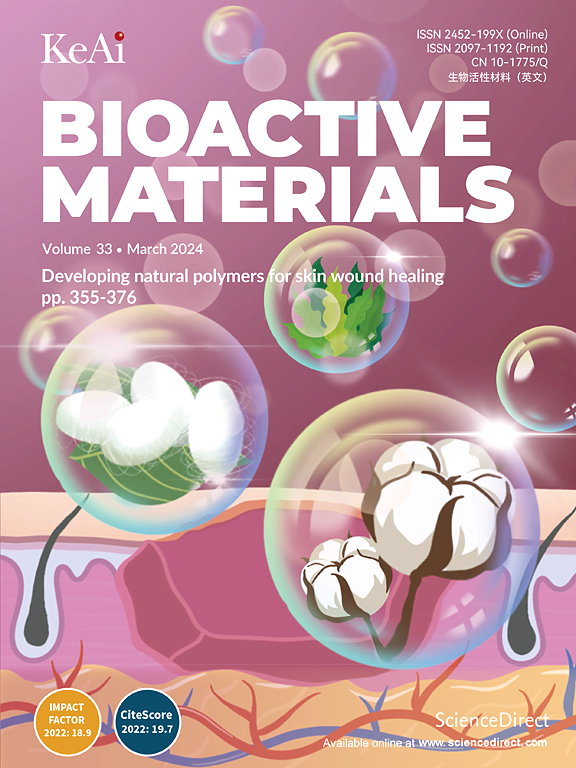Catalyst-modulated hydrogel dynamics for decoupling viscoelasticity and directing macrophage fate for diabetic wound healing
IF 18
1区 医学
Q1 ENGINEERING, BIOMEDICAL
引用次数: 0
Abstract
Dynamic hydrogels can regulate immune responses, but decoupling bond exchange kinetics from static mechanical properties remains challenging. Here, we present a catalyst-mediated strategy to independently tune hydrogel network dynamics without altering crosslinking density or stiffness. A reversible acylhydrazone-based hydrogel system was constructed using lysozyme and PEG, with 4-amino-DL-phenylalanine (4a-Phe) as a catalyst to modulate bond exchange rates. This strategy enables effective decoupling of hydrogel viscoelasticity, allowing precise modulation of stress relaxation rates (τ1/2) from 50 to 15 min, while maintaining nearly identical storage moduli (G′). The impact of hydrogel network dynamics on macrophage behavior was systematically investigated. Hydrogels with enhanced network dynamics significantly activated the JAK/STAT signaling pathway, promoting macrophage M2 polarization. These immunomodulatory effects fostered a pro-regenerative microenvironment, enhancing granulation tissue formation, angiogenesis, and accelerating wound closure in a diabetic mouse model. These findings underscore the significant potential of dynamic hydrogels in materiobiology, offering a novel approach to bridging materials science with immunoregulatory regenerative medicine.

催化剂调节水凝胶动力学解耦粘弹性和指导巨噬细胞命运在糖尿病伤口愈合
动态水凝胶可以调节免疫反应,但从静态力学特性中解耦键交换动力学仍然具有挑战性。在这里,我们提出了一种催化剂介导的策略,在不改变交联密度或刚度的情况下独立调节水凝胶网络动力学。以溶菌酶和聚乙二醇为原料,以4-氨基- dl -苯丙氨酸(4a-Phe)为催化剂调节键交换速率,构建了可逆的酰基腙基水凝胶体系。该策略可以实现水凝胶粘弹性的有效解耦,允许在50到15分钟内精确调节应力松弛速率(τ1/2),同时保持几乎相同的存储模量(G ')。系统研究了水凝胶网络动力学对巨噬细胞行为的影响。增强网络动力学的水凝胶显著激活JAK/STAT信号通路,促进巨噬细胞M2极化。在糖尿病小鼠模型中,这些免疫调节作用促进了促进再生的微环境,促进了肉芽组织的形成、血管生成和加速伤口愈合。这些发现强调了动态水凝胶在材料生物学中的巨大潜力,为材料科学与免疫调节再生医学之间的桥梁提供了一种新的方法。
本文章由计算机程序翻译,如有差异,请以英文原文为准。
求助全文
约1分钟内获得全文
求助全文
来源期刊

Bioactive Materials
Biochemistry, Genetics and Molecular Biology-Biotechnology
CiteScore
28.00
自引率
6.30%
发文量
436
审稿时长
20 days
期刊介绍:
Bioactive Materials is a peer-reviewed research publication that focuses on advancements in bioactive materials. The journal accepts research papers, reviews, and rapid communications in the field of next-generation biomaterials that interact with cells, tissues, and organs in various living organisms.
The primary goal of Bioactive Materials is to promote the science and engineering of biomaterials that exhibit adaptiveness to the biological environment. These materials are specifically designed to stimulate or direct appropriate cell and tissue responses or regulate interactions with microorganisms.
The journal covers a wide range of bioactive materials, including those that are engineered or designed in terms of their physical form (e.g. particulate, fiber), topology (e.g. porosity, surface roughness), or dimensions (ranging from macro to nano-scales). Contributions are sought from the following categories of bioactive materials:
Bioactive metals and alloys
Bioactive inorganics: ceramics, glasses, and carbon-based materials
Bioactive polymers and gels
Bioactive materials derived from natural sources
Bioactive composites
These materials find applications in human and veterinary medicine, such as implants, tissue engineering scaffolds, cell/drug/gene carriers, as well as imaging and sensing devices.
 求助内容:
求助内容: 应助结果提醒方式:
应助结果提醒方式:


